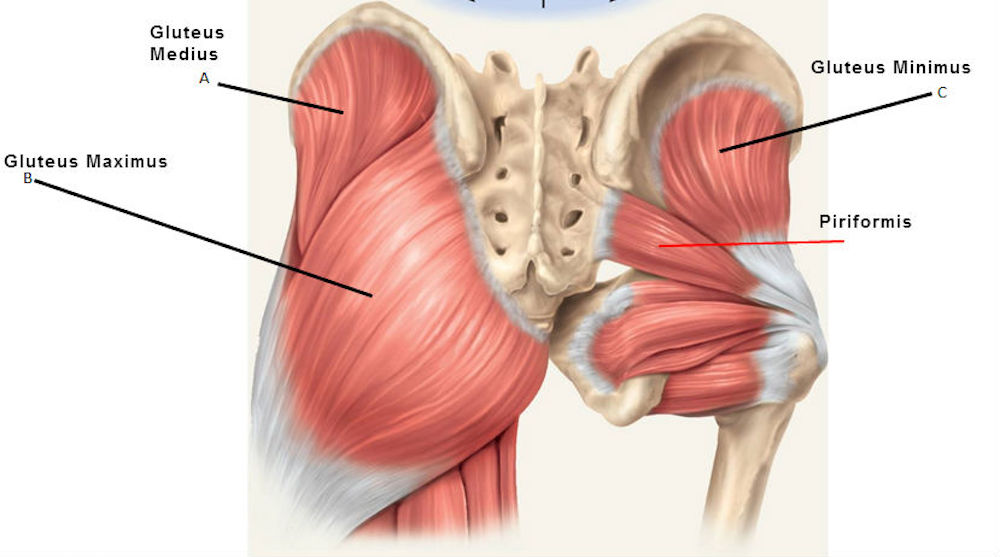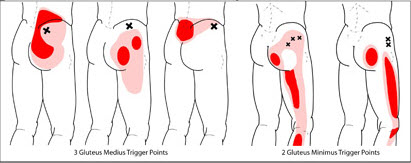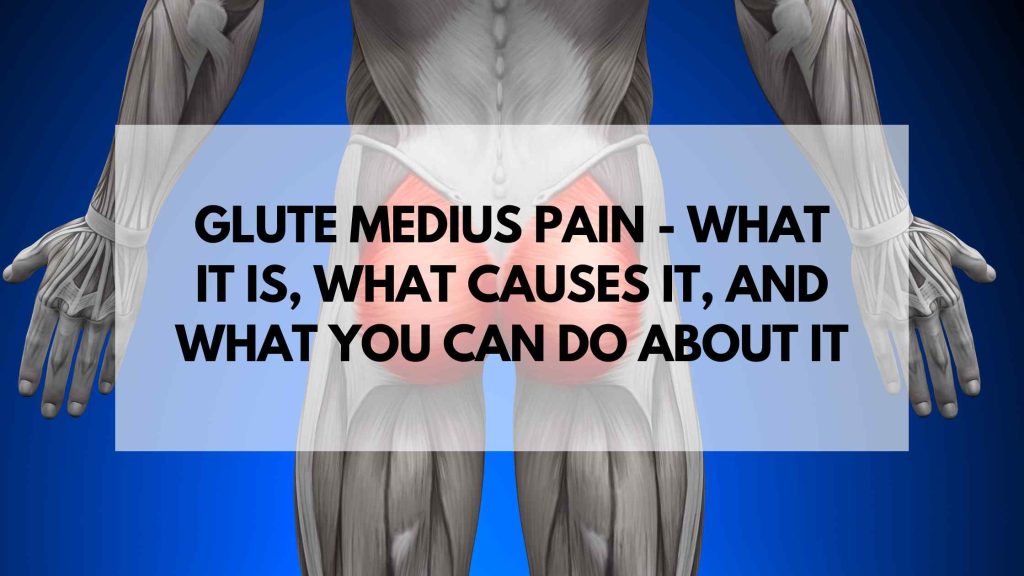So your bottom is tight and now your hip is hurting. You tried taking tylenol, advil or aleve but nothing changed. Ice and heat haven’t helped. Maybe you have even gone to physical therapy or tried massages but it keeps coming back. You heard this could be coming from your gluteus medius, that pesky muscle in your butt. What causes gluteus medius pain? What are the different types of injuries that happen to the gluteus medius? What are your treatment options? Is there something other than just rest, ice, physical therapy or a cortisone injection? What happens if you do nothing? Let’s explore what’s going on with your gluteus medius and what you can do for it.
What Is the Gluteus Medius? (Butt Muscle)

So here’s your butt. It’s made up of 3 different muscles that are important to keeping you standing up, not falling over to the side, and walking / running.
Gluteus Minimus
The gluteus minimus is the smallest of the 3 glute muscles. It sits right under the gluteus medius and it’s job is to stabilize the hip, rotate the thigh, and move the hip in an outward direction.
Gluteus Medius
This strong and powerful is the culprate of what many describe as “hip pain”. It actually attaches to the greater trochanter (your leg bone) and has a tendon that starts in the muscle and sticks right into your bone. This tendon often gets irritated and can be a huge source of pain.
The job of the gluteus medius is to stabilize the hip and pelvis, helps bend the hip upward (flexion), and rotates the leg inward and outward. Without this muscle, you’d fall right over.
Because of it’s functions and actions it’s often irritated and even weak in runners leading to a whole host of issues which we will discuss later in this article.
Gluteus Maximus
The Gluteus Maximus is the largest and most powerful of the three glute muscles. This muscle plays a key role in hip and thigh movement, including extension of the hip and outer rotation of the thigh. Its major function is in propulsion and endurance, participating significantly during running and climbing. It also contributes to the stabilization of the pelvis, particularly during walking or running. This muscle is also responsible for maintaining our upright posture, particularly when we’re standing. Consequently, it is a muscle that is engaged and worked frequently in our daily activities and can thus be prone to overuse and injuries.
Are there Different Types of Gluteus Medius Tendon Injuries?

- Tears – this occurs where the muscle turns to tendon. There are different types of tears and they can all cause pain in discomfort. This is generally localized at the site of the tear in the gluteus medius tendon right on your hip bone.
- Trigger Points – these are tight bands of muscle fiber that essential get knotted up. When trigger points in the gluteus medius occur, you can have pain both locally where the trigger points sit and also referred pain. Check out the picture below to see the pattern of referred pain from these trigger points.
- Muscle Inhibition – This is where the muscle is shut down and not functioning as it should. Generally a consequence of trigger points.
Causes of Gluteus Medius Pain & Injuries
Various factors can cause gluteus medius pain and injuries. Overuse is a common cause, especially among athletes and physically active individuals. It occurs when the muscle is excessively used without adequate rest, leading to strain and fatigue. This is particularly common in sports and activities that involve repetitive hip movements, such as running, hiking, and aerobics.
Poor biomechanics and muscular imbalances can also contribute to gluteus medius pain, where the muscle is overworked due to compensating for weaknesses in other areas of the body. This is commonly seen in individuals with a weak core or uneven leg length. Additionally, improper training techniques, poor posture, and inadequate warm-up before exercise can also lead to injury. In some cases, a direct trauma or fall can result in tears, leading to immediate pain and discomfort.
Aging and certain medical conditions such as arthritis can also increase the risk of injuries to the gluteus medius.
Gluteus Medius Tendonitis and Tendon Tear Symptoms
Gluteus medius tendonitis and tendon tears often manifest as debilitating pain at the hip, which can sometimes extend to the lower back and down the leg. This pain may be more pronounced during activities that engage the gluteus medius, such as walking, running, or climbing stairs, and may even persist during rest. The pain tends to increase when lying on the affected side, and a noticeable limp may develop due to the pain and weakness in the hip.
Alongside pain, other symptoms may include tenderness around the hip area, particularly where the tendon attaches to the hip bone. There may also be swelling and a reduced range of motion, making certain movements difficult. Some individuals may experience a sensation of the hip ‘giving way,’ and in more severe cases of a tendon tear, there may be a palpable gap at the site of the tear. It’s crucial to seek medical attention if these symptoms occur, as ignoring these signs can lead to further complications and prolonged recovery.
Diagnosis ( Physical Examination, X-ray and Ultrasound)
- X-ray – this is useless for gluteus medius pain conditions. X-rays just show bone and not soft tissue.
- MRI – an MRI can show tears in the gluteus medius tendon. The problem is that these tears are commonly asymptomatic (meaning they aren’t the source of people’s pain). The only way to know if finding on MRI correlates with the pain YOU are experiencing is by a thorough physical exam. If your doctor orders an MRI and doesn’t do a thorough physical exam then you cannot know for sure what is truly causing your pain.
- Physical exam – the gold standard when it comes to diagnosing and then treating gluteus medius pain. A thorough physical exam will look at range of motion of your hip and low back, muscle length testing and then comprehensively palpating your glute muscles and hip muscles to try and re-create your pain.
Conventional Treatment Options for Gluteus Medius Pain and Injuries (Conservative, Steroids & Surgery)
- Conservative Care – this includes rest, ice, heat, OTC meds, massage, and physical therapy. These options might be helpful for some and are worth exploring as a first line of care before you think about jumping into any invasive therapies. Just watching a bunch of youtube videos or instagram videos and blindly following advice can lead to you living with more pain and discomfort for much longer than you would experience without seeing a qualified practitioner.
- Steroids – steroid injections (cortisone) are often used for gluteus medius pain. The research on cortisone injections is poor at best when it comes to outcomes. Generally other therapies (like dry needling and prolotherapy) are more effective and safer in the long term. Steroid injections can lead to weakening of tendons and ligaments, and most studies show they lead to higher instances of arthritis and degeneration when used multiple times.
- Surgery – surgery is generally not on the table when it comes to non-traumatic (like you got in a horrific accident) gluteus medius pain.
Better Treatment Options for Gluteus Medius Pain (Dry Needling & Prolotherapy)
- Dry needling – an excellent tool to help treat trigger points in soft tissues like those that cause gluteus medius pain. This is a common technique I use in my practice in Tampa, FL for glute medius pain on a daily basis. We use a small needle to stimulate and release trigger points that cause a muscle to become short and tight. It’s a quick in office procedure and will generally require a few visits.
- Prolotherapy – a regenerative injection therapy where we use dextrose to stimulate a healing response in degenerated tissues. I default to prolotherapy when there is gluteus medius tendonitis or tendinosis. We can directly target the glute med tendon and stimulate it to heal and repair itself. Tendonitis can be a naggy condition that lasts for 12+ months if left untreated due to the avascular nature of tendons (they don’t have their own blood supply). With prolotherapy we can significantly speed up this process and get you feeling back to better.
Consequences of Not Treating Gluteus Medius Pain (Progression of Tear, Knee, Hip and Ankle Injuries Including Arthritis)
Pain is a warning sign that you have a problem that needs further investigation. Think of it like having a oil change warning light that pops up on your car – you can ignore the light and just keep driving but eventually your cars engine is going to blow up if you leave it too long. Pain is no different – it’s a gentle (or really strong) signal that something isn’t working right . You can mask it with pain killers but that doesn’t fix the problem. Then you’re left with severe arthritis and degeneration and you need a whole hip replacement when you’re 55 years old.
Potential consequences of not treating gluteus medius pain include:
- Progression of injury from tendonitis to partial thickness tear.
- Progression of partial thickness tear to complete tear with retractions. All nonsurgical treatment options are eliminated when this occurs.
- Knee instability. Dysfunction of the iliotibial band can cause lateral knee instability
- Knee osteoarthritis
- Changes in the way you walk (gait)
- Low back pain due to changes in the way you walk (gait)
- Develop hip osteoarthritis . The gluteus medius stabilizes the hip and pelvis. Without this stability the hip is at risk for cartilage, labrum and tendon injury.
- Ankle tendon, ligament and cartilage injuries including arthritis.
Conclusion
Neglecting gluteus medius pain can have severe consequences, underscoring the importance of timely treatment. Here are three compelling reasons for not avoiding treatment:
- Prevention of Further Damage: Without appropriate care, gluteus medius pain can escalate from inflammation to partial, and eventually, complete tear. Such progression not only exacerbates pain but eliminates several non-surgical treatment options.
- Avoidance of Joint-related Complications: Gluteus medius dysfunction can lead to knee instability and osteoarthritis, hip osteoarthritis, as well as ankle ligament, tendon, and cartilage injuries including arthritis. Treating the pain promptly helps prevent such downstream effects.
- Maintenance of Quality of Life: Ignoring gluteus medius pain can alter your gait, leading to low back pain and potential mobility issues. By addressing the problem early, you can continue to stay active and maintain a high quality of life.


